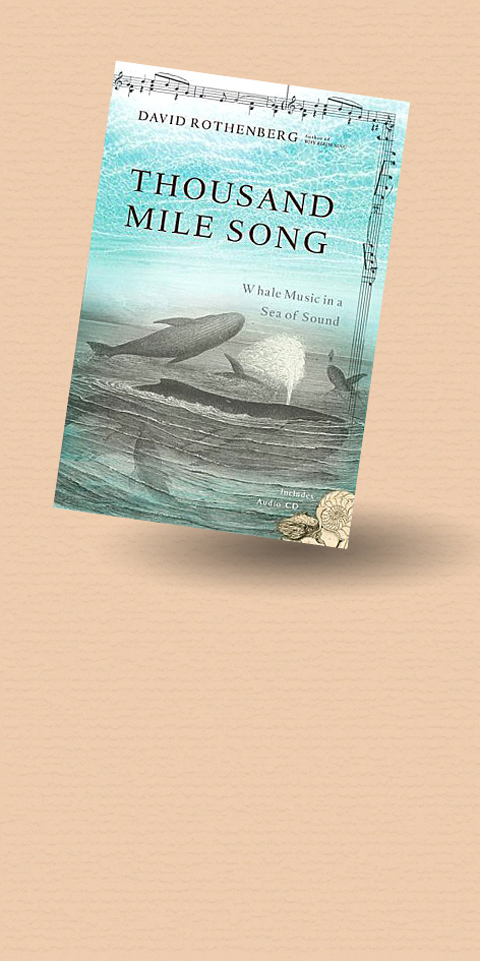Sailors have long known that whales make strange musical noises. Scholars believe that whales inspired the myth of the "siren songs" which lured Odysseus astray. Yet it wasn't until recording techniques were developed that anyone could listen to whale songs in their entirety. It was, in fact, military science that first collected the evidence. During the cold war, the US government conducted secret research into how sound travels underwater. The Americans were looking for ways to locate enemy submarines, and to hide their own. They knew that sound travels five times faster underwater than it does through the air, but they also found that it travels at different speeds in different layers of the ocean, fastest of all at the bottom. This may seem surprising, but as David Rothenberg explains: “The denser the medium, the faster the molecules shake as the [sound]wave goes through it."
While listening to the ocean, the scientists heard low moaning and rumbling noises that they gradually learned to identify (and dismiss) as the sound of “biologicals.” These turned out to be great whales communicating with one another in the deep sound channels, where their utterances traveled unimpeded across hundreds, even thousands of kilometers. In 1967, a navy researcher gave his humpback whale recordings to Roger Payne and Scott McVay, who in 1971 alerted the public to whale music through the journal Science. Other classified tapes became available to civilian researchers in 1991, under an inspired “dual uses initiative” pushed through by US senators Al Gore and Ted Kennedy. Only then did most cetacean scientists get their hands on 40 years’ worth of data about the movements and vocabulary of whales.
By listening to humpback whale songs through hydrophones, they discovered that whales do not keen and moan randomly. The songs — always sung by males — had long-range structures, sometimes lasting for hours. They were shaped like any good musical composition, with themes, phrases, climaxes, resolution and dying away. Moreover, the songs were repeated after a pause. They seemed to be transmitted to other whales living in the same area who sang them too. Different groups in other oceans had their own distinctive songs. The songs were too long and formal merely to be passing on simple information about females, food or the ocean floor. Strangest of all, they underwent slow but continuous evolution. Researchers who came back summer after summer noticed subtle changes in the songs each year, all the whales in the area picking up the changes. This means that whales are very different from birds, those other well-known singers of the natural world, whose songs remain stable over time. Whereas today’s nightingales may sound very similar to the ones that Shakespeare or Keats heard, a whale researcher will complain that the great whale singers of the 1970s have gone now, and that the music favored by today’s youngsters is entirely different.

Whales became big, so to speak, when endangered species caught our imagination in the 1970s. The idea that the world’s largest creatures were singing at the bottom of the ocean had great emotional power. Set against the knowledge that we were harpooning them in order to use their precious oil for soap, machine grease, lipstick and dog food, their majestic undersea laments suddenly made us feel guilty. Hippy musicians went out in boats to play to them. Did the whales respond? The musicians thought so. It was all meant to be a homage, an inter-species love-in, but it had to stop when the Marine Mammal Protection Act forbade anyone from harassing the animals and classed music as a form of harassment.
Sound in the deep ocean spreads out evenly from its source, making it very difficult to tell where it comes from. And so it is with Rothenberg’s style in this erratic but engaging book. He writes now as a philosopher, now as a New Age pantheist, now as a jazz clarinetist, and finally as a sober scientist. A musician himself, he considers the whales to be “grooving” in their own dark nightclubs. Included in the book is a CD of music that he has created around their songs. Most of the tracks use fragments of whale music he has sampled, transposed, speeded up, slowed down and interwoven with his own clarinet playing, which in turn is a sort of respectful mimicking of the barking, keening and tocking noises of the whales. Best are his live duets with them, recorded by broadcasting clarinet tones into the water. He calls it “jamming,” the jazzman’s term for free improvising. No matter how fine the motive, his interventions often seem an unwelcome dilution of the ancient, haunting noises the whales make when left to their own devices.
In this timely book, Rothenberg warns us that because of motorized shipping and seismic exploration of the ocean floor by oil companies, the seas are getting much noisier. There is evidence that whales are trying to sing louder to make themselves heard. Recent sonar tests by the US navy have been known to kill whales; they “developed a kind of decompression sickness because the frequency used by the navy matches the resonance frequency in the air space inside their heads.” Last year, the US navy “suddenly claimed an ‘exemption’ from the Marine Mammal Protection Act and gave itself permission to conduct whatever tests it wants for the next two years, citing national security as their justification.” We know that whale songs are complex messages, but we still don’t know what they mean or what we could learn from them, and now they may be under threat. As Henry David Thoreau said, “Can he who has discovered only some of the values of whalebone and whale oil be said to have discovered the true use of the whale?”

June 2 to June 8 Taiwan’s woodcutters believe that if they see even one speck of red in their cooked rice, no matter how small, an accident is going to happen. Peng Chin-tian (彭錦田) swears that this has proven to be true at every stop during his decades-long career in the logging industry. Along with mining, timber harvesting was once considered the most dangerous profession in Taiwan. Not only were mishaps common during all stages of processing, it was difficult to transport the injured to get medical treatment. Many died during the arduous journey. Peng recounts some of his accidents in

“Why does Taiwan identity decline?”a group of researchers lead by University of Nevada political scientist Austin Wang (王宏恩) asked in a recent paper. After all, it is not difficult to explain the rise in Taiwanese identity after the early 1990s. But no model predicted its decline during the 2016-2018 period, they say. After testing various alternative explanations, Wang et al argue that the fall-off in Taiwanese identity during that period is related to voter hedging based on the performance of the Democratic Progressive Party (DPP). Since the DPP is perceived as the guardian of Taiwan identity, when it performs well,

A short walk beneath the dense Amazon canopy, the forest abruptly opens up. Fallen logs are rotting, the trees grow sparser and the temperature rises in places sunlight hits the ground. This is what 24 years of severe drought looks like in the world’s largest rainforest. But this patch of degraded forest, about the size of a soccer field, is a scientific experiment. Launched in 2000 by Brazilian and British scientists, Esecaflor — short for “Forest Drought Study Project” in Portuguese — set out to simulate a future in which the changing climate could deplete the Amazon of rainfall. It is

What does the Taiwan People’s Party (TPP) in the Huang Kuo-chang (黃國昌) era stand for? What sets it apart from their allies, the Chinese Nationalist Party (KMT)? With some shifts in tone and emphasis, the KMT’s stances have not changed significantly since the late 2000s and the era of former president Ma Ying-jeou (馬英九). The Democratic Progressive Party’s (DPP) current platform formed in the mid-2010s under the guidance of Tsai Ing-wen (蔡英文), and current President William Lai (賴清德) campaigned on continuity. Though their ideological stances may be a bit stale, they have the advantage of being broadly understood by the voters.